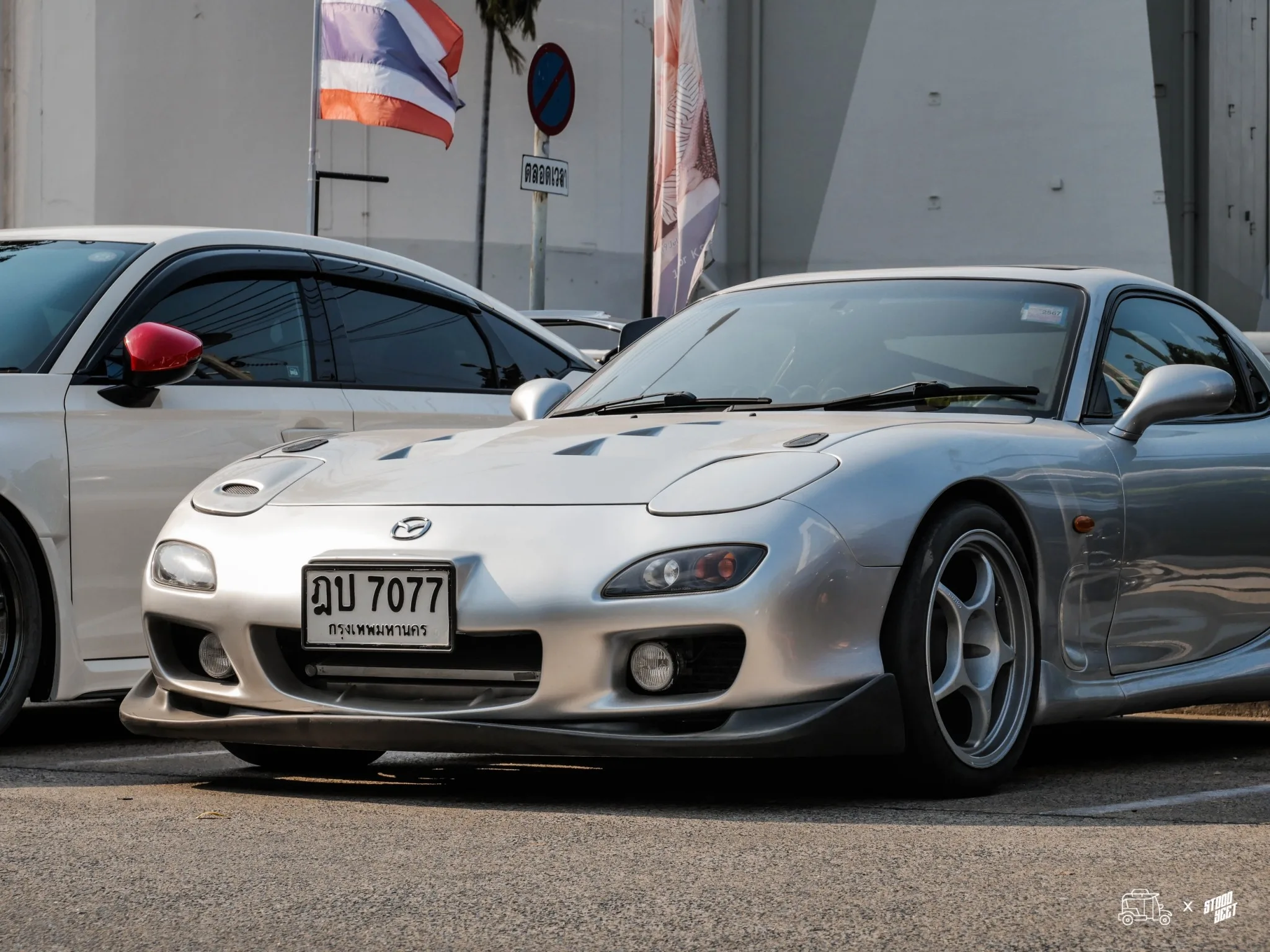Karkrub Review: Mazda RX-7
Specifications and Rarity in Thailand:
The Mazda RX-7 FD boasts a unique 1.3-liter twin-turbo rotary engine known as the 13B-REW, which at its peak could produce up to 276 horsepower due to Japan’s Gentleman’s Agreement on power limits. The compact, lightweight engine allowed for a well-balanced chassis, contributing to the car’s reputation as a driver’s car with exceptional handling characteristics.
In Thailand, the RX-7 FD is quite rare, as it was never officially sold in high volumes outside of its home market in Japan. Imported units are considered collector’s items, and the rotary engine’s complexity and maintenance requirements make it a less common sight on Thai roads.

History of the Model:
Introduced in 1991, the RX-7 FD was the third generation of Mazda’s RX series. It departed from its predecessors with a new, rounded and more aerodynamic body shape. The RX-7 FD became an icon of the 1990s Japanese sports car era, celebrated for its performance and the continuation of Mazda’s rotary engine legacy.
Development of the Model:
The RX-7 FD’s development focused on creating a lightweight sports car with a low center of gravity. Mazda’s engineers achieved this through the use of materials such as aluminum and composites for body panels, and a sophisticated suspension setup. The sequential twin-turbo system, a novel feature at the time, reduced turbo lag significantly, providing a smooth power curve.
Journalist Reviews at Time of Release:
Upon release, the RX-7 FD garnered praise for its dynamic abilities. Journalists highlighted its sharp handling, high-revving engine, and driver-focused cockpit. It was often compared favorably to its contemporaries, like the Toyota Supra and Nissan 300ZX, for its pure driving experience and unique engine.
Types of Modifications Typically Done:
Modifications on the RX-7 FD are as varied as their owners. Performance upgrades often include single turbo conversions for higher power output, ECU tuning, and improved cooling systems to manage the heat of the rotary engine. Suspension upgrades are also common to further enhance handling. Aesthetically, owners often opt for body kits, aftermarket wheels, and custom paint jobs. Interior upgrades usually focus on weight reduction and improving the driving interface, like aftermarket steering wheels, seats, and gauges.
The Mazda RX-7 FD remains a beloved model among enthusiasts, both for its driving dynamics and for its potential as a canvas for modification. Its rarity in Thailand only adds to its allure, making it a coveted piece for collectors and JDM aficionados.
Karkrub Score
Design: 9/10
The Mazda RX-7 FD’s design is a timeless amalgamation of smooth curves and an aggressive stance. The iconic pop-up headlights and sleek profile encapsulate the spirit of the 90s sports cars while maintaining a modern appeal. Its aerodynamic body not only looks stunning but also contributes to its exceptional handling. The design is almost universally praised for its beauty and function, hence the high score.
Power: 8/10
With its 1.3L twin-turbo rotary engine, the RX-7 FD offers an exhilarating power-to-weight ratio. While not the most powerful compared to modern standards, the rotary engine provides a unique driving experience with its high-revving nature and distinctive sound. It’s a driver’s car, with power delivery that’s both smooth and responsive, though it falls short of today’s horsepower figures.
Fun: 10/10
Fun is where the RX-7 FD shines the brightest. Its rear-wheel-drive layout, lightweight chassis, and balanced weight distribution make it a joy to drive. The car is known for its tail-happy nature and eagerness to dive into corners, providing an engaging driving experience that is hard to match. It’s the epitome of driving pleasure and receives a perfect score in this category.
Comfort: 6/10
Comfort is not the RX-7 FD’s strongest suit. The firm suspension and sporty setup are great for the track but can be unforgiving on long journeys or rough roads. The cabin is driver-focused and somewhat minimalistic, offering little in the way of luxury amenities. Space is also at a premium, making it less suitable for those seeking a comfortable cruiser.
Reliability: 5/10
Reliability is a known issue with the RX-7 FD, primarily due to the rotary engine’s maintenance needs and susceptibility to issues if not properly cared for. Parts can be scarce and expensive, and the car requires a knowledgeable and attentive owner to keep it running smoothly. This score reflects the car’s need for dedicated upkeep.
Safety: 6/10
For its time, the RX-7 FD came with the safety features expected of a sports car, but by today’s standards, it’s lacking. Absence of modern safety technologies such as multiple airbags, electronic stability control, and advanced driver-assistance systems marks it down in this category.
Value: 7/10
The value of the RX-7 FD has appreciated over time, particularly for well-maintained examples. It’s considered a collector’s car, and while it might not be the best value as a daily driver, as a piece of automotive history and joy, it holds its value quite well. The cost of maintenance and potential unreliability are counterbalanced by the car’s increasing rarity and desirability in the collector market.
Average Score: 7.3/10
The Mazda RX-7 FD scores high in terms of design, power, and the sheer fun of driving, which are core to its identity as a sports car. However, its scores are tempered by practical considerations like comfort, reliability, and safety. It excels as a collector’s item and a weekend warrior, offering an experience that’s rare to find in modern vehicles. Its value score reflects both its cost and its worth as an icon of automotive culture.

Leave a Reply